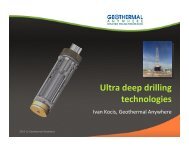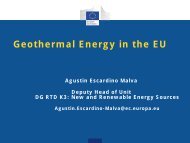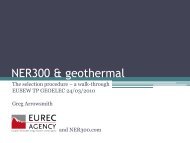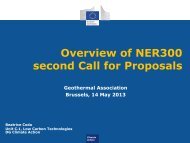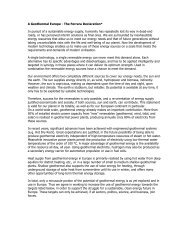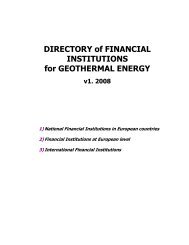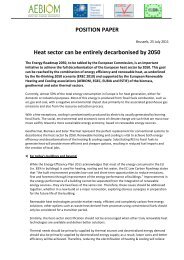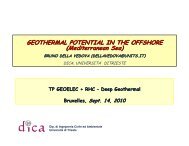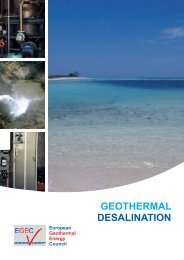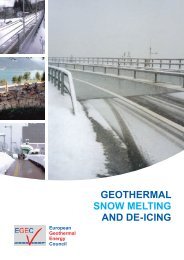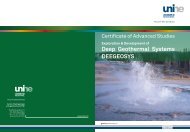Strategic Research and Innovation Agenda for Renewable ... - EGEC
Strategic Research and Innovation Agenda for Renewable ... - EGEC
Strategic Research and Innovation Agenda for Renewable ... - EGEC
You also want an ePaper? Increase the reach of your titles
YUMPU automatically turns print PDFs into web optimized ePapers that Google loves.
<strong>Renewable</strong>Heating & CoolingEuropean Technology Plat<strong>for</strong>mGEO.4ObjectiveSystem concepts <strong>and</strong> applications <strong>for</strong> geothermal cooling in warm climatesShallow geothermal energy offers advantages <strong>for</strong> cooling using the ground as a heat sink.However, this by now is mainly limited to Northern <strong>and</strong> Moderate climates with a pronouncedsummer/winter temperature swing.In warm climates or in the case of applications mostly used <strong>for</strong> cooling, additional re-coolingof the ground, hybrid systems, <strong>and</strong> short-term storage options etc. need to be developed inorder to allow <strong>for</strong> sufficient share of cooling from the groundState-of-the-artTargetsType of activityCooling in shallow geothermal systems has started in areas with colder climates, where addingthis feature is relatively simple on the side of the resource. Numerous good systems show thatthe concept works well under these conditions. Un<strong>for</strong>tunately, the highest cooling dem<strong>and</strong> is inwarmer climates, where ground temperatures are higher naturally, <strong>and</strong> design <strong>for</strong> high sharesof cooling is more of a challenge.• Allow shallow geothermal cooling <strong>for</strong> regions <strong>and</strong> applications not suitable by now,increase regional range of applicability to all Europe.• Increase efficiency of cooling in warm climate by 25%60% Development / 40% DemonstrationGEO.5ObjectiveState-of-the-artTargetsType of activityDevelopment of ground coupling technologies <strong>and</strong> installation techniques<strong>for</strong> high capacitiesWith the larger capacities required, <strong>and</strong> with the restricted area available on most building plots,improved ground coupling technologies must be developed, e.g. deeper BHE, BHE under buildings,“geoactive structures” (energy piles, parts of the building foundation as heat exchangers),or other technologies. For the work on larger construction sites, time <strong>and</strong> space restrictions are amajor problem. Improved drilling <strong>and</strong> installation techniques should be developed <strong>for</strong> work underthese conditions, also taking advantage of possible synergies by having several drill rigs workingat the same site.Most drilling rigs <strong>and</strong> installation equipment <strong>for</strong> BHE, groundwater wells etc. are designed <strong>for</strong> alimited number of boreholes at one spot. For larger buildings, more rigs <strong>and</strong> the related numberof skilled personnel are required. An underst<strong>and</strong>ing <strong>for</strong> the potential <strong>for</strong> automatisation of allprocesses has just started to grow.Allow drilling <strong>and</strong> installation in shorter time than today, <strong>and</strong> at sites with more limitations in area.Increase the potential <strong>for</strong> automatisation in the drilling <strong>and</strong> installation process.30 % Development / 70% Demonstration4.4.2 <strong>Research</strong> <strong>and</strong> innovation priorities with impact in the Medium <strong>and</strong> Long TermGEO.6ObjectiveIntegration of design of the shallow geothermal system <strong>and</strong> buildingenergy system with regard to optimum thermal use <strong>and</strong> operational strategyHeat transport in the underground is relatively slow, while building energy systems requirea prompt response. These characteristics can be matched by integrative design. However,the majority of geothermal heat pump systems today are planned in the classical way of theHVAC industry, by adding different components <strong>for</strong> heating <strong>and</strong> cooling to meet the requiredthermal capacities. For an optimum geothermal system, on the contrary, a holistic approachmust be taken, including the geothermal part, the conventional technology, <strong>and</strong> the wholebuilding <strong>and</strong> its intended use.In the case of most larger buildings, the geothermal system will be designed to cover asmuch as possible of the base load <strong>for</strong> heat <strong>and</strong> cold, being supplemented by other sources.The goal of design <strong>and</strong> development should be to ensure maximum contribution fromgeothermal (<strong>and</strong> other renewable) sources. Integrative design <strong>and</strong> construction approachesare required to optimise the common operation of the different system components, <strong>and</strong>storage <strong>and</strong>/or heat pumps are required to bridge gaps in capacity or temperature. ImprovedICT technologies (central digital building control, building automation systems) are crucial <strong>for</strong>operating these systems.State-of-the-artTargetsType of activityIn most cases geothermal systems today are designed as an add-on to conventional projectdesign in an advanced stage. So the geothermal technology just can try to adapt to the dem<strong>and</strong>as created by the planned project, <strong>and</strong> no adjustment of other parameters towards optimumoverall system concepts is possible. A change in practice <strong>and</strong> availability the necessary tools<strong>and</strong> structures <strong>for</strong> site investigation <strong>and</strong> design could create a leap <strong>for</strong>ward in system efficiency.• Increase system efficiency by 25 % <strong>and</strong> pursue a target of 100 % RES <strong>for</strong> the overallheating <strong>and</strong> cooling system.• Improve system reliability <strong>and</strong> operation stability.75% Development / 25% Demonstration47



